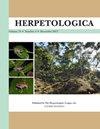No Evidence of Long-Term Effects on Physiological Stress or Innate Immune Functioning in Northern Map Turtles a Decade After a Freshwater Oil Spill
IF 1.1
3区 生物学
Q2 ZOOLOGY
引用次数: 1
Abstract
Abstract: Environmental perturbations such as chemical spills often have immediate and obvious effects on the health of ecosystems and individual organisms. However, the long-term effects of such perturbations are less evident and often less well-understood. In July 2010, a ruptured pipeline spilled diluted bitumen into the Kalamazoo River in Michigan, USA, ultimately oiling 56 km of the river channel. During spill cleanup operations, the most common vertebrate species rescued from the oiled river channel was the Northern Map Turtle (Graptemys geographica), of which over 2000 individuals were captured, cleaned of oil, and released. We returned to areas along the 2010 spill gradient to determine whether turtles from locations that had experienced different magnitudes of oiling in 2010 differed in baseline stress levels or immune functioning in 2020, which was 10 yr after the oil spill. In 2020, we collected blood samples from 100 individual Northern Map Turtles along the 2010 spill gradient and subsequently quantified the heterophil:lymphocyte ratio, bactericidal capacity, and natural antibody agglutination. We found no correlation between turtles' 2020 capture locations relative to the origin of the 2010 oil spill and either mean stress level (heterophil:lymphocyte ratio) or immune functioning (bactericidal capacity and natural antibody agglutination ability). Thus, we found no evidence that Northern Map Turtles sampled along a gradient of oil exposure resulting from the 2010 Kalamazoo River oil spill experienced long-term effects on physiological stress levels or immune functioning. Importantly, our sampling did not include any individuals that may have died during 2010–2020 from poor health after the oil spill and therefore is biased toward healthy turtles remaining in the population. Interestingly, we found that a subset of turtles known to have been oiled in 2010 actually had higher natural antibody titers than turtles sampled from a control site that presumably had never been exposed to oil. We cannot exclude the possibility of other long-term effects of the oil spill on the Map Turtle population, such as decreased reproductive output. We recommend that long-term monitoring of populations and ecosystems be included in spill mitigation plans to track the recovery of populations and ecosystems over time and to document any effects that may become evident only years after the spill event.淡水漏油十年后,没有证据表明北方地图龟对生理应激或天生免疫功能有长期影响
摘要:化学品泄漏等环境扰动往往对生态系统和个体生物的健康产生直接而明显的影响。然而,这种扰动的长期影响不太明显,人们往往不太了解。2010年7月,一条破裂的管道将稀释的沥青泄漏到美国密歇根州的卡拉马祖河中,最终使56公里的河道充满油污。在漏油清理行动中,从受污染的河道中获救的最常见脊椎动物是北方地图龟(Graptemys geographica),其中2000多只被捕获、清除油污并放生。我们回到了2010年漏油梯度沿线的区域,以确定来自2010年经历过不同程度油污的地区的海龟在2020年(即漏油10年后)的基线压力水平或免疫功能是否不同。2020年,我们沿着2010年的溢出梯度收集了100只北方地图龟的血液样本,随后量化了嗜异细胞:淋巴细胞比率、杀菌能力和天然抗体凝集。我们发现,相对于2010年漏油事件的起源,海龟2020年的捕获位置与平均压力水平(嗜异细胞:淋巴细胞比率)或免疫功能(杀菌能力和天然抗体凝集能力)之间没有相关性。因此,我们没有发现任何证据表明,2010年卡拉马祖河漏油事件导致的沿石油暴露梯度采样的北方地图龟对生理压力水平或免疫功能产生了长期影响。重要的是,我们的采样没有包括任何可能在2010-2020年期间因漏油后健康状况不佳而死亡的个体,因此我们倾向于在种群中保留健康的海龟。有趣的是,我们发现,已知在2010年被石油污染的一部分海龟的天然抗体滴度实际上高于从可能从未接触过石油的对照地点采样的海龟。我们不能排除石油泄漏对地图龟种群产生其他长期影响的可能性,例如繁殖能力下降。我们建议将对种群和生态系统的长期监测纳入泄漏缓解计划,以跟踪种群和生态系随时间的恢复,并记录泄漏事件发生几年后可能显现的任何影响。
本文章由计算机程序翻译,如有差异,请以英文原文为准。
求助全文
约1分钟内获得全文
求助全文
来源期刊

Herpetologica
生物-动物学
CiteScore
4.60
自引率
0.00%
发文量
27
审稿时长
>12 weeks
期刊介绍:
Established in 1936, Herpetologica is a quarterly peer-reviewed journal serving herpetologists, biologists, ecologists, conservationists, researchers and the scientific community. The journal contains original research papers and essays about the biology of reptiles and amphibians, and covers many relevant topics including: behavior, conservation, ecology, genetics, morphology, physiology and taxonomy.
 求助内容:
求助内容: 应助结果提醒方式:
应助结果提醒方式:


